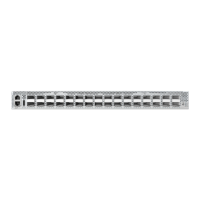C
HAPTER
17
| General IP Routing
Configuring IP Routing Interfaces
– 438 –
ROUTING PROTOCOLS The switch supports both static and dynamic routing.
◆ Static routing requires routing information to be stored in the switch
either manually or when a connection is set up by an application
outside the switch.
◆ Dynamic routing uses a routing protocol to exchange routing
information, calculate routing tables, and respond to changes in the
status or loading of the network.
CONFIGURING IP ROUTING INTERFACES
CONFIGURING LOCAL
AND REMOTE
INTERFACES
Use the IP > General > Routing Interface page to configure routing
interfaces for directly connected subnets (see "Setting the Switch’s IP
Address (IP Version 4)" on page 431.
If this router is directly connected to end node devices (or connected to
end nodes through shared media) that will be assigned to a specific
subnet, then you must create a router interface for each VLAN that will
support routing. The router interface consists of an IP address and subnet
mask. This interface address defines both the network prefix number to
which the router interface is attached and the router’s host number on that
network. In other words, a router interface address defines the network
segment that is connected to that interface, and allows you to send IP
packets to or from the router.
You can specify the IP subnets connected directly to this router by
manually assigning an IP address to each VLAN or using BOOTP or DHCP to
dynamically assign an address. To specify IP subnets not dirertly connected
to this router, you can either configure static routes (see page 447), or use
the RIP or OSPF dynamic routing protocols (see page 483) to identify
routes that lead to other interfaces by exchanging protocol messages with
other routers on the network.
Once IP interfaces have been configured, the switch functions as a
multilayer routing switch, operating at either Layer 2 or 3 as required.
All IP packets are routed directly between local interfaces, or indirectly to
remote interfaces using either static or dynamic routing. All other packets
for non-IP protocols (for example, NetBuei, NetWare or AppleTalk) are
switched based on MAC addresses).
To route traffic between remote IP interfaces, the switch should be
recognized by other network nodes as an IP router, either by setting it to
advertise itself as the default gateway or by redirection from another
router via the ICMP process used by various routing protocols.
If the switch is configured to advertise itself as the default gateway, a
routing protcol must still be used to determine the next hop router for any
unknown destinations, i.e., packets that do not match any routing table

